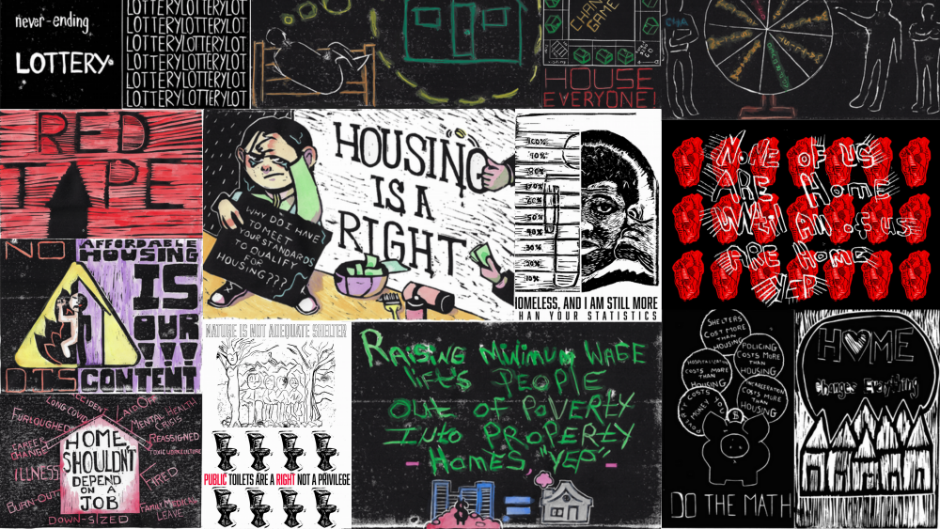The Human Rights Clinic's Housing and Homelessness team—Katirina Delviscio, Wilmy Dessalines, Tiana Rose Montague, and Nicholas Tricarico, working under the supervision of the clinic's associate director Tamar Ezer— had the unique opportunity to blend art and legal advocacy. Over the past two years, clinic students have collaborated with Red Line Service, named after the Chicago train line, where many unhoused individuals would seek refuge, which serves a community of artists in Chicago with lived experience of being unhoused.
Students facilitated a series of workshops via Zoom with the artists on the human right to housing. The workshops explored the seven dimensions of "adequate housing" under international human rights law: Legal Security of Tenure, Accessibility, Affordability, Availability of Services, Habitability, Location, and Cultural Adequacy.
"These dimensions reconstruct notions of housing from mere shelter into a foundation for peace, security, and dignity," said Delviscio. "When housing meets all these criteria, it creates opportunities for individuals and families to thrive, maintain cultural practices, and participate fully in their communities. The right to housing is not just a slogan, but rather a comprehensive framework under international law."
The Human Rights Clinic invited community activists to the workshops at the forefront of advocacy for a right to housing across the U.S., including in Los Angeles, Miami, New York City, and Washington, D.C. The advocates, many of whom had experienced homelessness, highlighted issues and initiatives related to the various dimensions of the right to housing.
After each workshop, the artists worked, creating prints reflecting on each dimension of housing adequacy in light of their experiences. "The artists transformed abstract legal principles into compelling visual narratives, resonating with emotion and the current reality in the U.S.," said Dessalines. "Together, they infused life into words and concepts, coloring them with the vibrant tones of lived experience."
The project provided the artists a platform to share their experiences, challenges, and hopes. "Through these workshops, I found it refreshing to be treated as a person capable of thought, even though I have been homeless and even though I have a diagnosed mental illness," one of the artists, Dave Scott, said. "To have a chance to consider the seven points, connect them to my life, find commonalities in our shared experience, have a chance to express those thoughts and feelings visually, and share the final product with the larger world, has made me feel valued and seen."
The art created is now available to support advocacy for the right to housing, and prints can be downloaded from Miami Law's "Art and the Right to Housing" webpage. "While the U.S. has not traditionally recognized a right to housing, there are exciting movements for a right to housing at state and local levels for which the prints can provide valuable inspiration and resources," Ezer said. "Art can facilitate conversations, shed light on injustice, and open our minds to the possibility of a different reality."
"The prints highlight that housing insecurity is a systemic issue, not a personal failure," said Tricarico. "They also demonstrate how the voices of those most affected might reshape our vision for social justice."
The art has already found an eager audience, including in Miami, which suffers from a deficit of more than 90,000 affordable housing units. "Our interviews with community advocates revealed that many renters feel trapped – forced to choose between unaffordable rents, unsafe housing, or the risk of homelessness," said Montague.
With the introduction of Florida Statute 125.0231 on Public Camping and Public Sleeping (formerly HB 1365), as well as local laws criminalizing homelessness, many individuals who cannot afford housing in this competitive landscape may now face criminal penalties for sleeping in public spaces without meaningful alternatives.
The Human Rights Clinic, in collaboration with partners Miami Coalition on Racial Equity and Struggle for Miami's Affordable and Sustainable Housing, hosted an exhibit in the community in conjunction with Art Basel and a follow-up exhibit at the University of Miami during the Beaux Arts Festival. The artwork has further traveled to the World Urban Forum, hosted by U.N.-Habitat in Cairo, Egypt, and the Lubeznik Center for the Arts in Michigan City, Indiana.
However, the power of the project goes beyond the prints produced. "When people with lived experience of houselessness drive the gathering of community," said Red Line Service's executive director Rhoda Rosen. "We are enacting the world we want to manifest—a world in which we belong to one another and owe to one another."
Read more about Miami Law’s Human Rights Law area of study.

